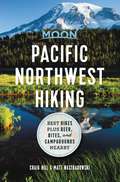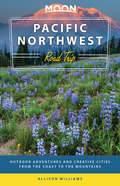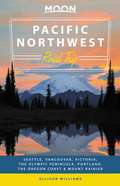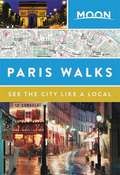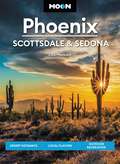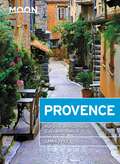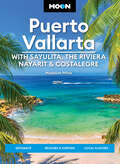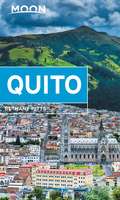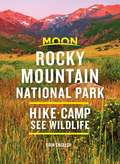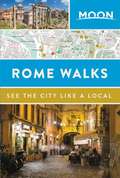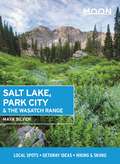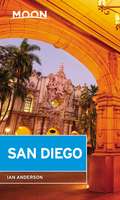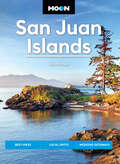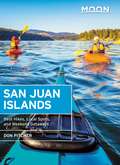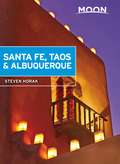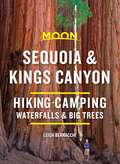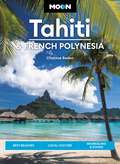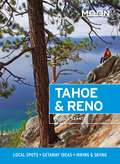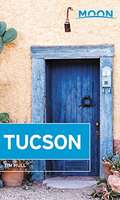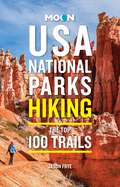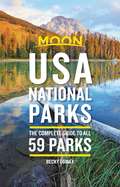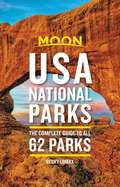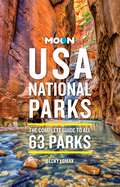- Table View
- List View
Moon Pacific Northwest Hiking: Best Hikes plus Beer, Bites, and Campgrounds Nearby (Moon Outdoors Ser.)
by Craig Hill Matt WastradowskiTowering peaks, sparkling coastline, and vast old-growth forests: wherever you turn in the Pacific Northwest, adventure awaits. Pack a lunch, lace up your boots, and hit the trails with Moon Pacific Northwest Hiking. Inside you'll find:Diverse Hiking Options: Whether you plan to take breathtaking coastal walks in Oregon or challenging treks around Mount Rainier, enjoy outdoor getaways ranging from easy day hikes to multi-day backpacking tripsFind Your Hike: Looking for something specific? Choose from strategic lists of the best hikes for waterfalls, wildflowers, bringing your dog, and more, plus a breakdown of the best hikes by seasonThe Top Outdoor Experiences: Wander through the damp, dense greens of a rainforest in Olympic National Park or revel in a Mars-like red rock landscape in southeastern Oregon. Watch an orange sunset on a beach adorned with sea stacks or gaze into the mouth of a volcano crater. Catch a glimpse of a bighorn sheep, see actual wagon ruts on the historic Oregon Trail, and stroll through fields of wildflowers. Walk behind a waterfall or take in unbridled views of the downtown Portland skyline Nearby Fun: Kick back at a local brewery after your hike, find a nearby campground for a night under the stars, or enjoy a plate fresh oysters with an ocean view Essential Planning Details: Each hike is described in detail and marked with round-trip distance and hiking time, difficulty, terrain type, elevation gain, and access pointsMaps and Directions: Find easy-to-use maps, driving directions to each trailhead, and details on where to parkExpert Advice: Seasoned hikers Craig Hill and Matt Wastradowski reveal their experienced insights, local secrets, and honest opinions of each trailTips and Tools: Advice on gear, first aid, and camping permits, plus background information on climate, landscape, and wildlifeMoon Pacific Northwest Hiking covers hikes in Washington and OregonWhether you're a veteran or a first-time hiker, Moon's comprehensive coverage and local expertise will have you gearing up for your next adventure.Hitting the road? Check out Moon Pacific Northwest Road Trip!
Moon Pacific Northwest Road Trip: Outdoor Adventures and Creative Cities from the Coast to the Mountains (Travel Guide)
by Allison WilliamsBuckle up for the best of the PNW's breathtaking wilderness, eclectic cities, and quaint coastal towns with Moon Pacific Northwest Road Trip. Inside you'll find:Multiple Routes: Take the full two-week trip or mix and match suggestions for spending time in the Olympic Peninsula, Seattle, Portland, the Oregon Coast, Vancouver, and moreEat, Sleep, Stop and Explore: With lists of the best hikes, views, and more, you can venture through lush rainforest in search of towering waterfalls, race across sand dunes on the Oregon Coast, and kayak the Puget Sound. Marvel at totem poles carved by First Nation tribes in Vancouver, study the contemporary masterpieces at the Seattle Art Museum, or tour Oregon's collection of picturesque lighthouses. Indulge in a food truck feast in Portland, sample cheese and ice cream in Tillamook, or snack on authentic Canadian poutineMaps and Driving Tools: Over 30 easy-to-use maps keep you oriented on and off the highway, along with site-to-site mileage, driving times, detailed directions, and full-color photos throughoutLocal Insight: Native Washingtonian and outdoorswoman Allison Williams shares her favorite spots and experiences in the Pacific NorthwestPlanning Your Trip: Know when and where to get gas, how to avoid traffic, tips for driving in different road and weather conditions, and suggestions for LGBTQ+ travelers, seniors, and road trippers with childrenWith Moon Pacific Northwest Road Trip's flexible itineraries and practical tips for weekend getaways or a complete PNW escape, you're ready to fill up and hit the road! Looking to explore more of the West on wheels? Try Moon Pacific Coast Highway Road Trip! Doing more than driving through? Check out Moon Coastal Oregon or Moon Olympic Peninsula. About Moon Travel Guides: Moon was founded in 1973 to empower independent, active, and conscious travel. We prioritize local businesses, outdoor recreation, and traveling strategically and sustainably. Moon Travel Guides are written by local, expert authors with great stories to tell—and they can't wait to share their favorite places with you.For more inspiration, follow @moonguides on social media.
Moon Pacific Northwest Road Trip: Seattle, Vancouver, Victoria, the Olympic Peninsula, Portland, the Oregon Coast & Mount Rainier (Travel Guide)
by Allison WilliamsHit the Road with Moon Travel Guides!Discover vibrant cities like Seattle, Vancouver, and Portland, and explore the emerald wilderness in between with Moon Pacific Northwest Road Trip. Inside you'll find:Maps and Driving Tools: 31 easy-to-use maps keep you oriented on and off the highway, along with site-to-site mileage, driving times, detailed directions for the entire route, and full-color photos throughoutEat, Sleep, Stop and Explore: With lists of the best hikes, views, and more, you can climb Mount Rainier or relax in Seattle with a freshly brewed cup of coffee or a local craft beer. Hike the temperate rainforests of Oregon, kayak the Puget Sound in Washington, hit the ski slopes in Whistler, or take the ferry to Canada to see First Nations art Flexible Itineraries: Drive the entire two-week route or follow suggestions for spending time in Vancouver, Victoria, the Olympic Peninsula, Seattle, the Oregon Coast, Portland, Neah Bay, Port Angeles, Greenwater, Paradise, Olympia, Astoria, Aberdeen, or NewportLocal Insight: Native Washingtonian and outdoorswoman Allison Williams shares her love of the Pacific NorthwestPlanning Your Trip: Know when and where to get gas, how to avoid traffic, tips for driving in different road and weather conditions, and suggestions for LGBTQ travelers, seniors, and road trippers with kidsWith Moon Pacific Northwest Road Trip's practical tips, detailed itineraries, and local know-how, you're ready to fill up the tank and hit the road.Looking to explore more of America on wheels? Try Moon Pacific Coast Highway Road Trip! Doing more than driving through? Check out Moon Seattle or Moon Vancouver.
Moon Paris Walks
by Moon Travel GuidesExperience the City of Lights like a local: on foot! Stroll along cobblestone alleys and grand boulevards, discover chic restaurants and trendy shops, and bask in la vie Parisienne with Moon Paris Walks. This full-color guide features: Six customizable walks through the city's hippest neighborhoods, including Montmartre, le Marais, Saint Germain, and more, with color-coded stops and turn-by-turn directions; Foldout maps of each route and a removable full-city map, in a handy, portable guide; Curated "Top Ten" lists for restaurants, shopping, nightlife, and activities for a sleepy Sunday, for visitors looking to hit the highlights; The top attractions and the best-kept local secrets: Meander cobblestone alleyways to find a local corner café, and people-watch from the terrace over lunch. Wander through the Latin Quarter to Notre Dame, and stroll through the verdant public gardens. Visit world-famous museums and galleries like the Louvre, or shop for designer threads at the hippest boutiques. Browse a Sunday flea market for fresh produce, and relax in the park with a baguette and fromage under the gaze of the Eiffel Tower. Discover trendy restaurants in the up-and-coming Belleville, sip stylish cocktails by the Seine, and dance the night away at the most popular nightclubs in town. Public transportation options, including the metro, bus, taxi, or bike rentalTips for first-time visitors, including seasonal festivals, where you'll need to make a reservation, and getting to and from the airport. With creative routes, public transit options, and a full-city map, you can explore Paris at your own pace, without missing a beat.
Moon Phoenix, Scottsdale & Sedona: Desert Getaways, Local Flavors, Outdoor Recreation (Travel Guide)
by Lilia MenconiWhether you're hiking red rock trails in the Valley of the Sun or relaxing in Scottsdale's resorts, take Arizona at your own speed with Moon Phoenix, Scottsdale & Sedona. Inside you'll find:Strategic, flexible itineraries like a luxurious desert getaway, a family road trip, and the 4-day best of the Valley of the Sun Unique experiences and can't-miss sights: Explore the local art scene, from Indigenous exhibits to contemporary galleries, and taste the best Sonoran-style cuisine this side of the Mexican border. Luxuriate in five-star resorts, world-class spas, and gourmet restaurants. Go stargazing in Sedona or bar-hopping in Scottsdale. Hike water-carved canyons and climb mountains or hit the links in the golf capital of the West. Discover the rich culture of the Indigenous peoples who first settled the Valley, and venture to the leafy respite of Oak Creek Canyon to picnic between trout-filled ponds and towering red-rock monoliths The top spots for outdoor adventures, from rock climbing and hiking along hidden mountain trails to sunset hot air ballooning and exhilarating desert Jeep tours Expert advice from Phoenix local Lilia Menconi on when to go, how to get around, and where to stay, with special focus on the best resorts in the area Full-color, vibrant photos and detailed maps throughoutThorough background on the culture, environment, wildlife, and history With Moon's practical tips and local know-how, you can experience Phoenix, Scottsdale, and Sedona your way. Expanding your trip? Try Moon Arizona & the Grand Canyon. Hitting the road? Try Moon Southwest Road Trip.About Moon Travel Guides: Moon was founded in 1973 to empower independent, active, and conscious travel. We prioritize local businesses, outdoor recreation, and traveling strategically and sustainably. Moon Travel Guides are written by local, expert authors with great stories to tell—and they can't wait to share their favorite places with you. For more inspiration, follow @moonguides on social media.
Moon Provence: Hillside Villages, Local Food & Wine, Coastal Escapes (Travel Guide)
by Jamie IveyFrom sweet-smelling lavender fields and beachside restaurants to rosé vineyards and truffle markets, Moon Provence reveals a feast for the senses. Inside you'll find:Flexible itineraries for exploring Provence at your own pace, including the best of the region in 7 days, a day in Aix-en-Provence, and more Strategic advice for art lovers, oenophiles, outdoor enthusiasts, and familiesThe top sights and unique experiences: Marvel at the lavender fields in full bloom, stroll through a market of fresh produce and artisan-made goods, or explore Avignon's Palais des Papes, the largest Gothic palace in the world. Step into the world of Van Gogh's art in Arles, village-hop through the charming Petit and Grand Luberon, or have a gladiator moment in a Roman arena. Hike in Les Alpilles Regional Park, bike the ascent of Mont Ventoux, one of the most punishing climbs on the Tour de France, or just play a game of pétanque by the beachThe best local flavors: Sip rosé where the wine was first created, try cured wild boar saucisson or a hearty bowl of daube de boeuf, and sample truffle cheesesHonest insight from Provence local Jamie Ivey on where to eat, sleep, and discover the true spirit of the South of FranceFull-color photos and detailed maps throughoutFocused coverage of Aix-en-Provence, The Luberon, Arles, Les Alpilles and the Camargue, Avignon and the Vaucluse, Marseille, and moreThorough background information on the landscape, wildlife, history, government, and cultureHandy tools including a French phrasebook, customs and conduct, and information for LGBTQ, solo, and senior travelers, as well as families and travelers with disabilitiesWith Moon's practical advice and insider tips, you can experience the best of Provence.Spending more time in France? Check out Moon French Riviera or Moon Normandy & Brittany.
Moon Puerto Vallarta: Getaways, Beaches & Surfing, Local Flavors (Travel Guide)
by Madeline MilneTowering mountains and turquoise sea, street food and cutting-edge cuisine, old-world vibes and world-class luxury: Explore a tropical paradise full of surprises with Moon Puerto Vallarta. Inside you'll find:Strategic, flexible itineraries with ideas for outdoor adventurers, beach bums, surfers, budget travelers, wellness seekers, and more, including a Costalegre road tripThe top outdoor adventures: Snorkel in the crystal-clear ocean, spot humpback whales and sea turtles out on the bay, or take a surfing lesson. Catch a sunset on the beach, go standup paddle boarding, or escape to the misty Sierra Madres for a hike Must-see highlights and unique experiences: Enjoy tacos from a street vendor, feast on Mexican delicacies at a waterfront restaurant, or drop anchor and grill your freshly-caught fish in a palapa. Shop from local artists along the Malecón, or spend a day volunteering at a turtle rescue camp. Visit a tequila distillery, sample local raicilla, and dance to cumbia as the sun sets over the beach How to experience Puerto Vallarta like an insider, support local and sustainable businesses, avoid crowds, and respectfully engage with the culture Expert insight from local writer Madeline Milne Full-color photos and detailed maps throughout Reliable background information on the landscape, climate, wildlife, and history, as well as common customs and etiquette Handy tools including a Spanish phrasebook, packing suggestions, and travel tips for families with kids, seniors, travelers with disabilities, travelers of color, and LGBTQ+ travelers Experience the best of Puerto Vallarta with Moon. Exploring more of Mexico? Check out Moon Baja, Moon Oaxaca, or Moon Mexico City. About Moon Travel Guides: Moon was founded in 1973 to empower independent, active, and conscious travel. We prioritize local businesses, outdoor recreation, and traveling strategically and sustainably. Moon Travel Guides are written by local, expert authors with great stories to tell—and they can't wait to share their favorite places with you. For more inspiration, follow @moonguides on social media.
Moon Quito (Travel Guide)
by Bethany PittsQuito is at once a vibrant young city and a traditional Sierra town, steeped in ancient culture and tucked between misty mountain peaks. Get to know both sides of this beautiful city with Moon Quito. Explore the City: Navigate by district or by activity with color-coded maps, or follow a guided walk through Quito's most interesting neighborhoodsSee the Sights: Stroll the cobblestone streets of Quito's Old Town (a UNESCO World Heritage Site!) and bask in the gilded glow of la Compañia church. Hike through cloud forests, spot Andean bears at a wildlife reserve, or climb the rugged Pichincha Volcano. Learn about the history of Ecuador's indigenous people at museums of pre-Colombian art and witness Guayasamín's masterpiece at the Capilla del HombreGet a Taste of the City: Eat with the locals at one of Quito's markets or savor innovative takes on traditional Ecuadorian cuisineBars and Nightlife: Linger at a café, dance the night away at the trendiest clubs, or bar-hop through la MariscalExpert Advice: Experience Quito like an insider with tips from local Bethany Pitts on where to eat, where to stay, and how to get around, including advice on supporting local businesses and respectfully engaging with the cultureItineraries and Day Trips: Spend a day or a full week in Quito, and explore nearby Calderón, Guayllabamba, Mindo, and moreFull-Color Photos and Detailed MapsHandy Tools: Background on the landscape, climate, and history, health and safety information, a Spanish phrasebook, volunteer opportunities, and travel tips for families with kids, seniors, travelers with disabilities, and LGBTQ travelersWith Moon Quito's practical tips and local know-how, you can plan your trip your way.Exploring more of South America? Check out Moon Chile or Moon Galápagos Islands.
Moon Rocky Mountain National Park: Hike, Camp, See Wildlife (Travel Guide)
by Erin EnglishHike to stunning glaciers and waterfalls, savor the solitude of the mountains, and sleep under the stars: an unforgettable adventure awaits with Moon Rocky Mountain National Park. Inside you'll find:Flexible Itineraries: Unique and adventure-packed ideas ranging from one day in the park to a week-long trip, with tips for family fun, winter adventures, and visiting all the glaciersThe Best Hikes in Rocky: Detailed trail descriptions with mileage, elevation gains, individual trail maps, and backpacking optionsExperience the Outdoors: Hike the dramatic glacier-formed gorges to find jaw-dropping waterfalls and spot elk, moose, and bighorn sheep along the way. Join in on a summertime ranger program, snowshoe to a ghost town in the winter, or catch the annual Perseid meteor shower in August. Take an adventurous bike tour, try your hand at rock climbing or fishing, and set up camp for a night under the stars (and a spectacular sunrise, too!)How to Get There: Up-to-date information on gateway towns, park entrances, park fees, and toursWhere to Stay: From campgrounds to B&Bs to the iconic Stanley Hotel, find the best spots to kick back, both inside and outside the parkPlanning Tips: When to go, what to pack, safety information, and how to avoid the crowds, with full-color photos and detailed maps throughoutExpertise and Know-How from seasoned explorer and Rocky Mountain local Erin EnglishExperience the magnificent natural beauty of Colorado's Rockies with Moon Rocky Mountain National Park.Visiting more of North America's national parks? Try Moon Zion & Bryce or Moon Yellowstone & Grand Teton. Trying to hit them all? Check out Moon USA National Parks.
Moon Rome Walks
by Moon Travel GuidesExperience Rome like a local: on foot! Enjoy a stroll (or passeggiata) through the bustling streets and cobblestone alleyways of the Eternal City, an ancient capital brimming with vibrant life. This full-color guide features: Six customizable walks through the city's hippest neighborhoods, including Prati, Trastevere, Monti, and more, with color-coded stops and turn-by-turn directions; Foldout maps of each route and a removable full-city map, in a handy, portable guide; Curated "Top Ten" lists for restaurants, famous film locations, Sunday activities, and nightlife; The top attractions and the best-kept local secrets: Wander along winding side streets and find traditional artisans, rare antiques, and trendy boutiques. Walk past the designer displays on Via dei Condotti, take a romantic evening stroll through the Villa Borghese, or people-watch from the Spanish Steps. Admire world-famous works by Bernini and Michelangelo, tour the Roman Forum and the Colosseum, or throw a coin into the Trevi Fountain. Mingle with locals at a Sunday market, find the best neighborhood pizza al taglio or fresh pasta, and discover innovative restaurants, trendy wine bars, and the city's most popular nightclubs. Public transportation options, including the metro, public buses, and taxis. Practical tips for first-time visitors, such as average costs, where you'll need to make a reservation, public holidays, and getting to and from the airport. With creative routes, public transit options, and a full-city map, you can explore Rome at your own pace, without missing a beat.
Moon Salt Lake, Park City & the Wasatch Range: Local Spots, Getaway Ideas, Hiking & Skiing (Travel Guide)
by Maya SilverDiscover brooding mountains, dense forests, and the "greatest snow on earth," just beyond the city limits. Inside Moon Salt Lake, Park City & the Wasatch Range you'll find:Flexible itineraries, from weekends in Salt Lake or Park City to day trips to nearby ski resorts and state parksStrategic advice for outdoors lovers, families, craft beer enthusiasts, festival-goers, and moreOutdoor adventures: Ski the legendary powder at one of Cottonwood Canyons' four resorts, kayak the otherworldly Great Salt Lake, and venture into the vast Uinta Mountains and picnic by a high alpine lake. Climb to the top of Mount Timpanogos for sweeping views, test your nerve on a steep rock-climbing route in Little Cottonwood Canyon, or marvel at the fall color in Wasatch Mountain State ParkMust-see highlights and unique experiences: Immerse yourself the Wild West-meets-Hollywood vibe of Sundance, uncover Mormon history at Temple Square, stroll Ogden's historic main street, and kick back with a craft beer at one of Utah's many emerging breweriesHonest advice from Park City local Maya Silver on when to go, where to eat, and where to stayFull-color photos and detailed maps throughoutFocused coverage of Salt Lake City, Park City, Big and Little Cottonwood Canyons, Ogden, the Great Salt Lake Desert, the Wasatch Back, Oakley, Kamas, and the UintasThorough background on the culture, weather, wildlife, and historyFind your adventure with Moon Salt Lake, Park City & the Wasatch Range.Looking for coverage of the whole state? Try Moon Utah. Exploring nearby? Pick up Moon Zion & Bryce.
Moon San Diego (Travel Guide)
by Ian AndersonCatch a wave, explore the buzzing craft beer scene, or just hang loose on the beach. Whether you're seeking thrills or kicking back, get a taste of the SoCal lifestyle with Moon San Diego. Inside you'll find:Flexible, strategic itineraries including the best of the city, beaches, and breweries, plus ideas for family-friendly funThe top sights and unique experiences: Swim at Ocean Beach or kayak around La Jolla Cove. Hop on the San Diego Trolley to explore historic Old Town, shop for Mexican pottery, or take a surfing lesson. Snap a pic with the pandas and polar bears at the renowned San Diego Zoo and stroll through the museums in Balboa Park Get a Taste of the City: Savor authentic Baja-style cuisine or belly up to the window of a food truck for fresh fish tacosBars and Nightlife: Sample a flight of craft beers at a trendy brewery, bar crawl along Pacific Beach or in the Gaslamp Quarter, or watch a movie under the stars at one of the city's outdoor cinemasLocal insight from brew enthusiast, avid surfer, and San Diego native Ian AndersonDay trips from San Diego: Taste wines in Temecula, enjoy the wildflowers in Anza-Borrego State Park, or cross the border into Tijuana Honest advice on when to go, where to stay, and how to get aroundMaps and Tools like background information on the history and culture of the city, easy-to-read maps, full-color photos, and neighborhood guides from historic Old Town to seaside CoronadoWith Moon San Diego's practical tips and local know-how, you can experience the best of the city.Can't enough of the Golden State? Try Moon California. Hitting the road? Try Moon Pacific Coast Highway Road Trip.
Moon San Juan Islands: Best Hikes, Local Spots, Weekend Getaways (Moon U.S. Travel Guide)
by Don Pitcher Moon Travel Guides'Island time' isn't just for the tropics: Escape to evergreen forests, rocky shorelines, and the glittering sea with Moon San Juan Islands. Inside you'll find:Flexible itineraries like a 10-day best of the islands and a weeklong family camping trip, with coverage of gateway towns such as Anacortes, Whidbey Island, and Bellingham, plus nearby Seattle Unique experiences and can't-miss sights: Picnic on cliffs overlooking the ocean or paddleboard on a tranquil lake. Visit local farms filled with fragrant lavender or fluffy alpacas and sip wine or cider at island vineyards. Savor the flavors of the Pacific Northwest at incredible farm-to-table restaurants, sample oysters fresh from the sea, or browse your way through quirky bookstores and funky antique shops The best outdoor adventures: Go sea kayaking or glide through glimmering nighttime waters during a bioluminescence tour. Marvel at the islands' marine life, including orcas, humpback whales, porpoises, and seals, during a whale-watching trip. Sail around the islands or fish for salmon, cod, and halibut. Take a forest hike, spot rare birds, or bike through rolling farm country and along the stunning shorelines Expert advice from former wilderness ranger Don Pitcher on when to go, how to get around, and where to stay, from romantic B&Bs to stunning campsites Full-color photos and detailed maps throughoutThorough information on the landscape, climate, wildlife, and history With Moon's practical tips and local insight, you can experience the San Juan Islands your way. Exploring more of the Pacific Northwest? Check out Moon Coastal Oregon or Moon Columbia River Gorge & Mount Hood.About Moon Travel Guides: Moon was founded in 1973 to empower independent, active, and conscious travel. We prioritize local businesses, outdoor recreation, and traveling strategically and sustainably. Moon Travel Guides are written by local, expert authors with great stories to tell—and they can't wait to share their favorite places with you. For more inspiration, follow @moonguides on social media.
Moon San Juan Islands: Best Hikes, Local Spots, and Weekend Getaways (Travel Guide)
by Don Pitcher'Island time' isn't just for the tropics: Escape to evergreen forests, pebbled shorelines, and the glittering sea with Moon San Juan Islands. Inside you'll find:Flexible itineraries like a 4-day best of the islands and a weeklong family camping trip, with coverage of gateway towns such as Anacortes, Whidbey Island, and Bellingham, plus nearby Seattle and VictoriaUnique experiences and can't-miss sights: Picnic on cliffs overlooking the ocean or paddleboard on a tranquil lake. Spot playful orcas and check out the Whale Museum in Friday Harbor. Visit local farms filled with fragrant lavender or fluffy alpaca and sip wine or cider at island vineyards. Savor the flavors of the Pacific Northwest at incredible farm-to-table restaurants, sample oysters fresh from the sea, or browse your way through quirky book stores and funky antique shopsThe best outdoor adventures: Go sea kayaking alongside whales or glide through glimmering nighttime waters during a bioluminescence tour. Set your sights on the islands' marine life, including killer whales, humpback whales, porpoises, and seals, during a whale-watching trip. Sail around the islands or fish for salmon, cod, and halibut. Take a forest hike, spot rare birds, or bike through rolling farm country and along the stunning shorelinesExpert advice from former wilderness ranger Don Pitcher on when to go, how to get around, and where to stay, from romantic B&Bs to stunning campsitesFull-color photos and detailed maps throughoutThorough information on the landscape, climate, wildlife, and historyWith Moon's practical tips and local insight, you can experience the San Juan Islands your way.Hitting the road? Try Moon Pacific Northwest Road Trip. Seeing more of The Evergreen State? Check out Moon Washington or Moon Seattle.
Moon Santa Fe, Taos & Albuquerque (Travel Guide)
by Steven HorakWhether you're in search of hot peppers, boundary-pushing art, or a scenic mesa hike, explore the Land of Enchantment's unique magic with Moon Santa Fe, Taos & Albuquerque. Inside you'll find:Strategic, flexible itineraries with ideas for art-lovers, outdoor enthusiasts, and more, plus weekend getaways to each of the three citiesThe top experiences and unique activities: Take a hike (for a day or even a week) along aspen-filled mountainsides or ski the thrilling downhill runs of Taos Valley. Check out the vibrant art, film, and music scene in Santa Fe, wander through crumbling Franciscan mission churches, or visit ancient cave dwellings. Uncover New Mexico's countercultural side at quirky stops like the Tinkertown Museum or a ghost town, sample authentic Southwestern cuisine (don't skimp on the hot chiles!), and observe a tribal dance ceremony at one of the state's many pueblosLocal insight from Santa Fe resident Steven HorakHonest advice on when to go, where to stay, and how to get aroundNotable sights outside of the cities, including: Pecos National Historical Park, Los Alamos, Bandelier National Monument, Acoma Pueblo, the Turquoise Trail, the Jemez Mountain Trail, and moreFull-color, vibrant photos and detailed maps throughoutThorough information including background on the landscape, wildlife, climate, and local cultureWith Moon Santa Fe, Taos & Albuquerque's practical tips and local know-how, you can experience New Mexico your way.Exploring more of the Southwest? Try Moon Arizona & the Grand Canyon or Moon Zion & Bryce. Hitting the road? Try Moon Southwest Road Trip.
Moon Santa Fe, Taos & Albuquerque (Travel Guide)
by Steven HorakExperience the art installations, adobe pueblos, and rugged high desert trails of the Land of Enchantment. Inside Moon Santa Fe, Taos & Albuquerque you'll find:Flexible itineraries for art-lovers, outdoors enthusiasts, families, and more, including weekend getaways to each of the three citiesYear-round outdoor adventures: Race down the slopes of Taos Ski Valley or mountain bike through stands of piñon and juniper near Santa Fe. Hike through thick alpine forests, raft the wild rapids of the Rio Grande Gorge, or capture the best view in New Mexico from a hot air balloon. Wander around the archeological sites and cave apartments of Bandelier National Monument, spot elk in Valles Caldera National Preserve, or trek alongside ancient rock carvings at Petroglyph National MonumentTop experiences and unique activities: Mingle with local artists in the vibrant galleries of Santa Fe, visit Georgia O'Keefe's studio at Ghost Ranch, and experience peak relaxation at a world-class spa. Observe a traditional dance ceremony at a pueblo, admire handmade art and jewelry at the Santa Fe Indian Market, and learn about Native American history at one of the region's many cultural museumsTastes of the Southwest: Dive into traditional New Mexican dishes drenched in spicy red and green chile sauces or indulge in a juicy green chile cheeseburger. Sip on a sunset margarita at a mellow open-air bar or taste local spirits in a trendy cocktail lounge. Take a culinary tour of Santa Fe's growing food truck scene or explore Albuquerque's lively beer cultureExpert insight from Santa Fe local Steven HorakHelpful resources on COVID-19 and traveling in New MexicoVibrant full-color photos and detailed maps throughoutBackground information on the landscape, wildlife, climate, and local cultureWith Moon Santa Fe, Taos & Albuquerque's practical tips and local insight, you can experience the best of New Mexico. Exploring more of the Southwest? Try Moon Phoenix, Scottsdale & Sedona or Moon Southwest Road Trip. Hitting the parks? Try Moon Grand Canyon or Moon Zion & Bryce. About Moon Travel Guides: Moon was founded in 1973 to empower independent, active, and conscious travel. We prioritize local businesses, outdoor recreation, and traveling strategically and sustainably. Moon Travel Guides are written by local, expert authors with great stories to tell—and they can't wait to share their favorite places with you.For more inspiration, follow @moonguides on social media.
Moon Sequoia & Kings Canyon: Hiking, Camping, Waterfalls & Big Trees (Travel Guide)
by Leigh BernacchiAscend towering peaks, take in awe-inspiring views, and get to know some of the oldest, tallest, and rarest living things on Earth with Moon Sequoia & Kings Canyon. Inside you'll find:Flexible Itineraries: Unique and adventure-packed ideas for day hikers, winter visitors, families with kids, campers, and more The Best Hikes in Each National Park: Detailed hike descriptions, trail maps, mileage and elevation gains, and backpacking optionsExperience the Outdoors: Behold greatness at the base of a giant sequoia, stop and smell the wildflowers of Zumwalt Meadow, or savor panoramic views from the summit of Mount Whitney (the highest peak in the continental US!). Strap on snowshoes for a ranger-led winter walk or spelunk your way around otherworldly rock formations in Crystal Cave. Cool off in the mist of a trailside waterfall, conquer the 400-step climb to the top of Moro Rock, and gaze at ink-black skies with unbeatable views of the Milky WayHow to Get There: Up-to-date information on traveling between the parks, gateway towns, park entrances, park fees, and toursWhere to Stay: From RV or tent campgrounds to rustic cabins and all-inclusive lodges, find the best spots to kick back, both inside and outside the parksPlanning Tips: When to go, what to pack, safety information, and how to avoid the crowds, with full-color photos and easy-to-use maps throughoutExpert Insight: Former national park ranger Leigh Bernacchi provides helpful background on the parks' history, geology, conservation efforts, and moreFind your adventure in Sequoia and Kings Canyon national parks with Moon.Exploring more of America's parks? Check out Moon USA National Parks.
Moon Tahiti & French Polynesia: Best Beaches, Local Culture, Snorkeling & Diving (Travel Guide)
by Chantae RedenWhether you&’re hiking through lush forests, diving deep among coral reefs, or just kicking back on the beach, indulge in island life with Moon Tahiti & French Polynesia. Inside you&’ll find:Flexible itineraries for solo travelers, honeymooners, and families, including two weeks experiencing the best of French Polynesia, a weeklong romantic getaway, and a trip to the awe-inspiring archaeological sites of the Marquesas Islands Must-see highlights and unique experiences: Dance to the beat of Tahitian drums at a Polynesian cultural festival, admire striking views of Moorea&’s volcanic landscape from Belvedere Lookout, and fall asleep under the stars from the comfort of your overwater bungalow in Bora Bora. Venture out to the Marquesas Islands for dramatic landscapes, secluded beaches, and the best handicrafts in the region, visit ancient tikis, and feast on delicious fresh seafood and tropical fruit Outdoor adventures: Get up close with migrating humpback whales and scuba dive with sharks, manta rays, sea turtles, and more. Trek along a jungle trail in search of refreshing waterfalls, paddle a traditional outrigger canoe across a bright blue lagoon, or unwind on the pink and white shores of idyllic Tikehau How to experience Tahiti and French Polynesia like an insider, support local and sustainable businesses, avoid over-tourism, and respectfully engage with the culture Expert insight from writer, photographer, and experienced diver Chantae Reden on where to eat, how to get around, and where to stay, from overwater bungalows and luxurious resorts to budget guesthouses Full-color photos and detailed maps throughoutReliable background information on the landscape, climate, wildlife, and history, as well as common customs and etiquette Experience the best of French Polynesia with Moon. Looking for more islands? Check out Moon Fiji or Moon Bali & Lombok.
Moon Tahoe & Reno: Local Spots, Getaway Ideas, Hiking & Skiing (Travel Guide)
by Moon Travel Guides Nicole SzantoFrom the glittering lake and trail-lined mountains to Old West towns and artsy urban centers, experience the best of this adventurous region with Moon Tahoe & Reno. Inside you'll find:Flexible itineraries, including a week-long Lake Tahoe road trip, long weekends for both winter and summer, and the one-week best of Tahoe and RenoStrategic advice for hikers, skiers, beach bums, families with kids, foodies and brewery lovers, and moreThe best hikes in Tahoe: Find your adventure, from challenging mountain treks to serene meadow walks, with trail descriptions, difficulty ratings, and mapsOutdoor adventures for any season: Hit the slopes and get the first tracks through snow-covered pines or spark your adrenaline on the Heavenly Blue Streak zipline. Mountain bike along the breathtaking cliffside Flume Trail, whitewater raft down the Truckee River, and kayak the crystalline waters of Emerald Bay. Hike the rugged Rubicon Trail along the shores of Lake Tahoe to the remarkable Vikingsholm Castle or trek a section of the famed Pacific Crest Trail. Take a relaxing dip in a natural hot spring, soak in the serenity of a secret beach, and watch the sun set over the lakeMust-see highlights and unique experiences: Drive around Lake Tahoe's 72-mile shoreline, stop at scenic viewpoints, and meander through Old West mountain towns. Stroll past the sculptures and boutiques of Reno's Truckee Riverwalk or explore the interactive installations of Reno Playa Art Park. Take a ride on a 150-year-old railroad route or descend deep into an underground mine. See what's on tap at Reno's award-winning craft breweries, sip craft cocktails in a trendy lounge or try your luck at a casinoExpert advice from Tahoe local Nicole Szanto on where to eat, where to stay, and how to minimize your environmental impactFull-color photos and maps throughout, including a fold-out map Thorough background on the weather, wildlife, and history, plus tips on getting there and getting around by car and public transportationWith Moon Tahoe & Reno's practical tips and local insight, you can plan your trip your way.Want to keep on driving? Pick up a copy of Moon Northern California Road Trips.
Moon Tijuana, Ensenada & Valle de Guadalupe Wine Country (Travel Guide)
by Jennifer KramerIndulge in tacos and beers on the beach, sip your way through a boutique vineyard, and cruise along the stunning Baja coast with Moon Tijuana, Ensenada & Valle de Guadalupe Wine Country. Inside you'll find:Flexible itineraries including a five-day road trip, a weekend in Tijuana, three days in wine country, and a four-day getaway to EnsenadaStrategic advice for road-trippers, foodies, wine enthusiasts, outdoor adventurers, and moreOutdoor adventures and unique experiences: Cruise down Mexico's Highway 1 and feel the warm Baja breeze on your face. Catch a local fútbol game or peruse an art gallery in Tijuana's buzzing Zona Centro. Spot great white sharks off the volcanic shores of Isla Guadalupe, hike to the El Vallecito cave paintings, or trek through canyons to hidden waterfalls. Catch a wave in Rosarito or explore a sunken ship on a diving expedition The best local flavors: Sample varietals from indie winemakers, head to Tecate for Mexico's favorite cerveza, or hit a modern craft brewery for an afternoon tasting. Grab fish tacos, ceviche tostadas, and steamy tamales from a food truck. Indulge in fresh pastries at a 24-hour bakery. Feast on fresh lobster in Puerto Nuevo, enjoy a wood-fired meal at an outdoor campestre restaurant, and try the unique Mediterranean and Asian twists of Baja Med cuisineExpert insight from Baja tour guide Jennifer Kramer on where to go, how to get around, and how to support local businesses Full-color photos and maps throughoutReliable background on the landscape, climate, wildlife, and history, plus health and safety advice and information on border crossingsHandy tools including a Spanish phrasebook and travel tips for families with kids, seniors, travelers with disabilities, and LGBTQ+ travelersExperience the best of Tijuana, Ensenada, and the Valle de Guadalupe Wine Country with Moon.Want más Mexico? Check out Moon Yucatán Peninsula, Moon Oaxaca, or Moon Puerto Vallarta.
Moon Tucson (Travel Guide)
by Tim HullSee Tucson with a Local!Experience the laid-back atmosphere and vibrant culture of this artsy desert enclave with Tucson local Tim Hull.What you'll find in Moon Tucson:Strategic, flexible itineraries that can be adapted for your schedule, including: "The Best of Old Pueblo in Three Days," "Sonoran Desert Adventures," "Midtown Biking," and "Southwest Style"Full-color, vibrant photos and detailed maps Honest advice on when to go, where to stay, how to get there, and how to get aroundThe top sights and unique activities: Visit remnants of ancient cultures, or explore vestiges of the Old West's legendary conquistadores, cowboys, and outlaws. Browse galleries of Pueblo art, hit an eclectic fusion restaurant, and shop for one-of-a-kind Native American crafts. Find the best resorts for golfing or a spa day, taste phenomenal Mexican food, and discover the top spots to sample the local nightlifeDetailed coverage of restaurants, shops, and nightlifeExpert insight from Tucson local Tim HullSuggestions for excursions outside of the city, including Kartchner Caverns and the Huachuca Mountains, Bisbee and Tombstone, the Border Region, and Willcox and the Chiricahua Mountains Thorough information, including background on the landscape, plants and animals, climate, and local cultureWith Moon Tucson's curated advice, myriad activities, and local insight, you can experience the city your way.Exploring more of the Southwest? Try Moon Arizona & the Grand Canyon or Moon Santa Fe, Taos & Albuquerque. Hitting the road? Try Moon Southwest Road Trip.
Moon USA National Parks Hiking: The Top 100 Trails (Moon Hiking Travel Guide)
by Jason Frye Moon Travel GuidesPick a park, find your trail, and embark on an unforgettable journey in America&’s top national parks with outdoors expert Jason Frye. Inside Moon USA National Parks Hiking you&’ll find:Coverage of 100 hiking trails across 40 national parks, from Acadia to Zion, organized by region Strategic lists and itineraries: Choose from lists of the best day hikes, accessible trails, hikes by season, hikes without crowds, and more, or make your way down the list of the top hiking experiences across the country Detailed hike descriptions and trail maps marked with distance, duration, effort level, and trailheads Outdoor adventures: Spot wildlife in their natural habitat, catch the sunrise, or stargaze. Take a dip in mountain streams, cast your line in a lake, and stop for a photo at stunning waterfalls Comprehensive planning resources: With maps and transportation tips, you&’ll have the tools to explore each park or region individually, or visit multiple for an epic national parks trip Trusted advice from writer and outdoors expert Jason Frye on how to avoid crowds, what time of year to visit, and where to stay inside and outside the parks, from campgrounds to hotels Know before you go: Find essential background on climate, terrain, wildlife, history, and trail safety, plus practical information on park fees, passes, and reservations, including how to obtain and use a National Parks Pass Gorgeous, full-color photos throughout From family-friendly adventures to strenuous mountain climbs, hit the trails with Moon USA National Parks Hiking. For more in-depth information on a specific park, check out one of Moon&’s national parks travel guides.About Moon Travel Guides: Moon was founded in 1973 to empower independent, active, and conscious travel. We prioritize local businesses, outdoor recreation, and traveling strategically and sustainably. Moon Travel Guides are written by local, expert authors with great stories to tell—and they can't wait to share their favorite places with you. For more inspiration, follow @moonguides on social media.
Moon USA National Parks: The Complete Guide to All 59 Parks (Travel Guide)
by Becky LomaxThey've been dubbed America's best idea for a reason: get inspired, get outdoors, and discover the wild beauty of the United States with Moon USA National Parks. Inside you'll find:Coverage of all 59 national parks, from the misty mountains of the east and the redwoods of the west, to the glaciers of Alaska and volcanoes of Hawaii, organized by regionStrategic lists and itineraries: Choose from lists of the best parks for hiking, wildlife, families, and scenic drives, or make your way down the list of the top ten national parks experiences across the countryThe best outdoor adventures in every park, including backpacking, biking, mountain climbing, kayaking, rafting, and more, plus detailed hike descriptions and trail maps marked with distance, duration, effort level, and trailheadsNational parks road trips with driving times and advice for linking multiple parks, interesting stops between them, and nearby attractions and state parksComprehensive planning resources: With detailed maps and transportation tips, you'll have the tools to explore each park or region individually, or visit multiple for an epic national parks tripExpert advice from former park guide Becky Lomax on how to avoid crowds, what time of year to visit, and where to stay inside and outside the parks, from campgrounds to hotelsKnow before you go: Find essential background on climate, terrain, wildlife, history, and safety precautions, plus practical information on park fees, passes, and reservations, including how to obtain and use a National Parks PassGorgeous, full-color photos throughout, plus a handy keepsake section for your national parks stamps and a detachable fold-out poster mapWhether you're trekking to striking vistas, rafting a wild river, or camping under the stars, find your park adventure with Moon USA National Parks.For more in-depth information on a specific park, check out Moon's national parks travel guides.
Moon USA National Parks: The Complete Guide to All 62 Parks (Travel Guide)
by Becky LomaxThey've been dubbed America's best idea for a reason: get inspired, get outdoors, and discover the wild beauty of the United States with Moon USA National Parks. Inside you'll find:Coverage of all 62 national parks, from the misty mountains of the east and the redwoods of the west to the glaciers of Alaska and volcanoes of Hawaii, organized by regionStrategic lists and itineraries: Choose from lists of the best parks for hiking, wildlife, families, and scenic drives or make your way down the list of the top ten national parks experiences across the countryThe best outdoor adventures in every park, including backpacking, biking, climbing, kayaking, rafting, and more, plus detailed hike descriptions and trail maps marked with distance, duration, effort level, and trailheadsNational parks road trips with driving times and advice for linking multiple parks, interesting stops between them, and nearby attractions and state parksComprehensive planning resources: With maps and transportation tips, you'll have the tools to explore each park or region individually, or visit multiple for an epic national parks tripExpert advice from former park guide Becky Lomax on how to avoid crowds, what time of year to visit, and where to stay inside and outside the parks, from campgrounds to hotelsKnow before you go: Find essential background on climate, terrain, wildlife, history, and safety precautions, plus practical information on park fees, passes, and reservations, including how to obtain and use a National Parks PassGorgeous, full-color photos throughout, plus a handy keepsake section for your national parks stamps and a detachable fold-out poster mapWhether you're trekking to striking vistas, rafting a wild river, or camping under the stars, find your park adventure with Moon USA National Parks.For more in-depth information on a specific park, check out one of Moon's national parks travel guides.
Moon USA National Parks: The Complete Guide to All 63 Parks (Moon National Parks Travel Guide)
by Becky Lomax Moon Travel GuidesGet inspired, get outdoors, and discover the wild beauty of the United States with parks expert Becky Lomax. Inside Moon USA National Parks you&’ll find:Coverage of all 63 national parks, from the misty mountains of the east and the redwoods of the west to the glaciers of Alaska and volcanoes of Hawaii, organized by region Strategic lists and itineraries: Choose from lists of the best parks for hiking, wildlife, families, and scenic drives or make your way down the list of the top ten national parks experiences across the country The best outdoor adventures in every park, including backpacking, biking, climbing, kayaking, rafting, and more, plus detailed hike descriptions and trail maps marked with distance, duration, effort level, and trailheads National parks road trips with driving times and advice for linking multiple parks, interesting stops between them, and nearby attractions and state parks Comprehensive planning resources: With maps and transportation tips, you'll have the tools to explore each park or region individually, or visit multiple for an epic national parks trip Expert advice from former park guide Becky Lomax on how to avoid crowds, what time of year to visit, and where to stay inside and outside the parks, from campgrounds to hotels Know before you go: Find essential background on climate, terrain, wildlife, history, and safety precautions, plus practical information on park fees, passes, and reservations, including how to obtain and use a National Parks Pass Gorgeous, full-color photos throughout, plus a handy keepsake section for your national parks stamps and a detachable fold-out poster mapWhether you're trekking to striking vistas, rafting a wild river, or camping under the stars, find your park adventure with Moon USA National Parks. For more in-depth information on a specific park, check out one of Moon's national parks travel guides.About Moon Travel Guides: Moon was founded in 1973 to empower independent, active, and conscious travel. We prioritize local businesses, outdoor recreation, and traveling strategically and sustainably. Moon Travel Guides are written by local, expert authors with great stories to tell—and they can't wait to share their favorite places with you. For more inspiration, follow @moonguides on social media.
